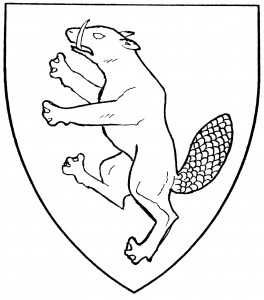The beaver is a wise and gentle beast, whose medieval reputation was of industry and, strangely enough, chastity: because its testicles were held to have medicinal value, it was said the beaver would bite them off when hunted, and thus escape its hunters. It is found in period armory in the canting arms (German Biber) of Biber, c.1340 [Zurich 212], and of von Bibra, 1605 [Siebmacher 100].
The beaver is drawn in heraldic art with a broad, flat tail, as seen in nature – the tail is the beaver’s defining trait – but there’s little further resemblance between the herald’s depiction and the naturalist’s. (The Society makes an exception when the beaver is blazoned “proper”; it’s then colored brown, and is more likely to be drawn naturalistically.) There doesn’t seem to be a default posture; the illustration, from the arms of Bibrach or Biberach, 1413 [Conz.Const. ccviii, also Siebmacher 196], shows a beaver rampant.
Esteban Castore bears: Vert, a beaver sejant erect gnawing on a silver birch tree proper.
Dauidh Fullam bears: Per bend sinister gules and Or, a beaver sejant erect counterchanged.
Issabella Oger of Buckie bears: Argent, a beaver rampant azure.
